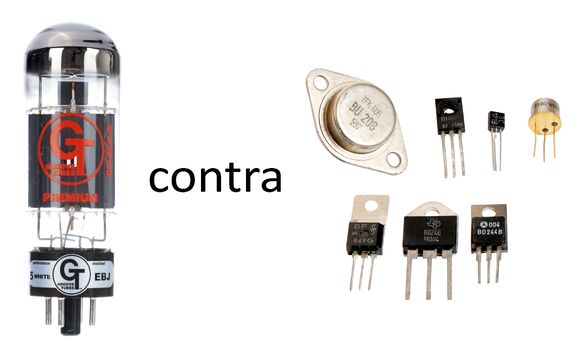Transistors vs Tubes
For years, transistors in guitar amps were seen as cheap and bad imitations of the good old tube technology. However, transistors have managed to gain ground. Thanks to sophisticated circuitry, transistor guitar amps now power numerous guitars on stages worldwide. Unlike the general trend where tube tech has almost completely faded into obscurity in electronic devices, good old tube amps still hold a high place among guitarists and bassists. There are now only a very limited number of manufacturers building tubes. Tubes are much more expensive than transistors or chips, and the technology is much more prone to faults. What makes the tube so different for guitarists?
In short - it's the sound! Unlike HiFi tech, a guitar amp is supposed to alter the sound of the signal. The effect feared elsewhere, where a signal becomes distorted due to overdrive, is what creates the distinctive sound in a guitar amp. And precisely in this overdrive range (whether in the preamp or power amp), tubes behave differently than transistors. Because tube amps have a simpler circuit design, they respond faster to the signal than transistors. Tubes are driven with much higher voltages. Another advantage: Due to their forgiving overdrive behavior, tube amp power is perceived as nearly twice as loud as transistor power.
Most guitarists see their guitar amp as its own instrument. The classic rock sound is created both in the tube preamp and power amp, interacting with the speakers (where distortions also occur). The physical effect is that high levels are sent to the speaker coil, and the level is electromagnetically influenced depending on the movement of the speaker cone. Since the speaker converts only a limited portion of the level into sound energy, part of this energy goes back to the power amp - causing it to distort. Power amp distortion occurs only at a certain overall volume.
For classic metal sound, the focus is more on preamp distortion. The signal is compressed more here, and the power amp, with more headroom, delivers a defined sound.
Some manufacturers have started building hybrid amps to integrate a tube circuit in the preamp, while using a transistor amp to bring the overdriven sound to level in the power amp. Others simulate or model the tube sound with DSP circuits. The results nowadays are impressive - often, a well-modeled sound is indistinguishable from the original. Additionally, this technology allows simulating various "tube amp types." So, when buying a good modeling amp, you get a selection of different "tube amps" and their characteristic sounds.
In the budget-friendly entry-level range, transistor amps dominate the market today. Even though they aren't universally loved, they deliver decent results and, considering the price, offer outstanding value for money.
Ambitious guitarists appreciate the sound of expensive tube tech and accept that their tube amp occasionally needs new tubes to sound "fresh" again. They know their amp is "super heavy" (plus a proper guitar cabinet) and that it's more sensitive.
The experimenting middle-ground has embraced the compromise between transistor circuits and tube preamps or modeling amps.
For more information on guitar amps, check out the Online Guide on Tube Amp Heads


